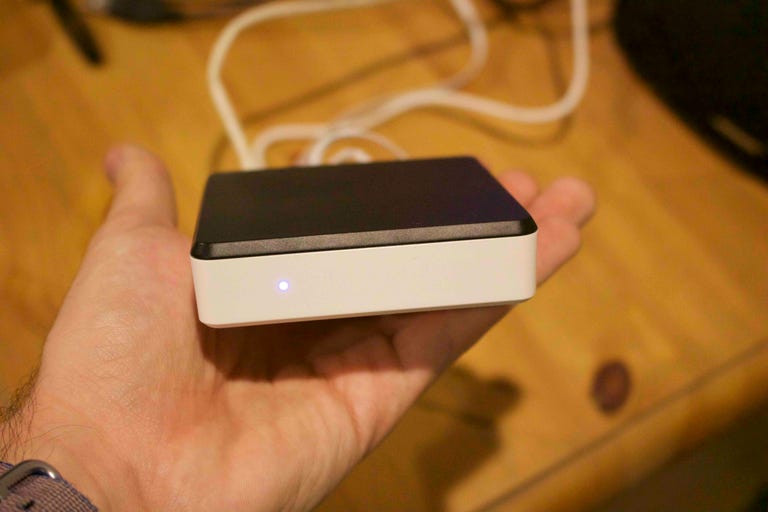 Why You Can Trust CNET
Why You Can Trust CNET Invoxia Voice Bridge review: Never miss a landline call again
The Voice Bridge doesn't come with a monthly fee, but that means it also misses some features you may want.
If you've heard of Invoxia before, it's likely because of Triby, the company's fridge-friendly speaker that was the first non-Amazon device with built-in Alexa voice support. But now the French company is back with Voice Bridge, a tiny networking box that accesses your landline from any iPhone, iPad or iPod Touch. (You may see the Voice Bridge sold under the name "Swissvoice," a brand that Invoxia acquired in 2013.) The hardware costs $99 or £79, but -- unlike some similar services -- there's no recurring subscription fee. The Voice Bridge doesn't appear to be available in Australia, but the US price converts to about AU$130.
The Good
The Bad
The Bottom Line
Like a lot of other telephone accessories, Voice Bridge lives in the VoIP space -- voice over internet protocol -- but not in the traditional sense. Usually, a VoIP service replaces a traditional landline, instead routing phone calls over the web. Invoxia's approach is to live alongside an existing landline, and forward those calls to an iOS device. (Android support is in beta.) More uniquely, the Voice Bridge can also allow you to remotely make calls from your mobile device using the landline number. That means, in theory, you could call from an iPhone in Europe via your US-based landline to another US-based number, and avoid any international long distance charges.
Those are some very niche features, and -- if you're already using applications like Skype, WhatsApp or Google Voice -- you can already make calls worldwide ranging from free to cheap. But for those who actually want to route mobile calls through their landline number, the Voice Bridge delivers. And it doesn't cost you anything beyond the one-time hardware purchase.
Using Voice Bridge IRL
In addition to the Voice Bridge hardware (measuring 3.13 inches square, 0.8 inch tall; 7.95cm square, 2cm tall), you get a telephone cable, an ethernet cable and a power adapter (with several interchangeable international plugs included). The Voice Bridge doesn't support Wi-Fi, but since it's just a box you plug in and forget about, we're not holding that against it. You will need to make sure your router and phone jack are within close proximity, however.
You set up and control the Voice Bridge through an app on your iOS device (again, Invoxia says that Android support is coming soon). The app is pretty easy to use, walking you through the setup and, as long as both devices are on the same network, it should eventually work. For instance, in order for my iPhone to find the Voice Bridge base station, I had to log the phone off my home Wi-Fi network and sign back on, but on second try it connected. From there, you should automatically start receiving your landline calls on your cell.
When you're in the application, it's easy to pick up a call or to decline it. And call quality was good: I tried it on both Wi-Fi and LTE and found identical reception quality, the only issue was it could take a few seconds to connect to the call on cellular. The delay was a bit more pronounced when I called from my iPhone to a friend's phone through the app (using my landline to do so).
The biggest caveat is that Voice Bridge doesn't play nice with old-school physical answering machines. If the Voice Bridge takes too long to forward the call, the machine might intercept it. There's no way to integrate those answering machines into the application yet, and if the machine grabs the call first you can't take it. Of course, most of you probably have cloud-based voicemail services, so this caveat wouldn't apply.
Only five devices can be connected to one Voice Bridge, but that should be enough for an average household. When a call comes through, it will hit all connected devices with the app. A neat little extra is an intercom tool hidden within the app that lets you reach those connected to the same Voice Bridge. When a call comes through it will provide the name or the number depending on the caller ID information available.
I'd like to see Invoxia improve the experience of receiving forwarded calls when an iPhone is locked. Right now, you can't just swipe to answer, and waiting for the app to open can be a pain. Perhaps that's something that can be addressed in an iOS 10 version.
It does one thing, but does it well
As I said, there are plenty of app-based solutions that let you make free or cheap phone calls. And many of the traditional VoIP products, such as Ooma or cable service "triple play" options, let you automatically forward landline calls to other numbers.
But I don't know of any service that lets you make outgoing landline calls from your mobile phone. And the fact that the Voice Bridge does it all without charging any fees is notable. Invoxia still has some work to do -- the Android version needs to exit beta, it should be easier to answer incoming calls from the lock screen -- but in the meantime, the Voice Bridge largely delivers on its promise.



